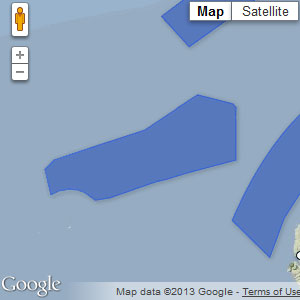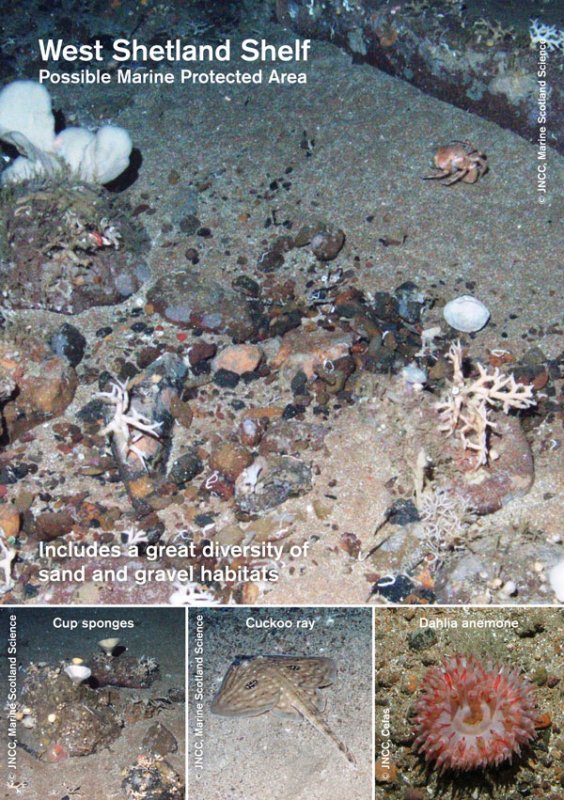Lying to the north of Scotland in offshore waters, the West Shetland Shelf MPA overlaps with the Windsock Fisheries Area which is managed for the recovery of cod. The MPA has been chosen for the wide variety of sand and gravel habitats present in the area, providing an important example of the northern extent of their range on the continental shelf in Scotland’s seas. From coarse gravels to fine-grained sands, the different habitats provide conditions suitable for a diverse range of animals to thrive in and on the seabed. [1]
Management measures for this site were proposed by Scottish Government late last year. Save Scottish Seas campaign members have assessed the Scottish Government’s management proposals for this site as part of its consultation response.
Read our comment on the proposed management measures here:
We support the restriction of dredging and beam trawling across the site. We also support restrictions for demersal trawl and seines. However, we would urge further protection for offshore subtidal sands and gravels covering the known habitat points in the west of the site owing to the data confidence in habitat occurrence.
Our understanding is that current measures are in place for mobile demersal gear as part of the Cod Recovery Plan (i.e. ‘Windsock’) and that if the windsock area were to be reopened to mobile demersal gear, this gear type would be subsequently managed under MPA measures within the site. We suggest that this site should also be strictly monitored for cod. We understand that cod is not a designated feature of the site, yet it is important to consider how this site may continue towards cod recovery, particularly as cod is a Priority Marine Feature. Furthermore, efforts towards gear conflict management should be a priority for this site.
.
History of this MPA
Save Scottish Seas campaign members have assessed the Scottish Government’s MPA proposal for this site as part of its consultation response.
Read our response to the MPA network consultation here:
LINK supports the designation of the West Shetland Shelf (formerly Windsock) possible Nature Conservation MPA to protect a wide variety of offshore subtidal sand and gravel habitats. The boundary and area are supported based on the advice provided that the area represents a rich mosaic of offshore sand and gravel biotope habitats, and a resident constituency of diverse marine fauna, at the northern extent of their range on the continental shelf in Scotland’s seas. This possible MPA will provide vital protection for nursery grounds for a whole range of fish species associated with sand and gravel beds, such as flatfish, bass, skates, and rays. A number of the species are recognised as PMF for conservation protection, including the commercial cod (Gadus morhua) which has been protected from fishing in the overlapping Windstock Fisheries area since 2001.
We accept the conservation objective of ‘conserve – feature condition uncertain’. However, we note that selection guideline 2d was not considered to be met for the protected biodiversity features in this site as sensitivity analyses concluded that there is a risk that features have been modified by human activity.
Management Options:
Management options for protected features of uncertain condition must be evidence-based, account for the known vulnerability of the protected features to human activities and make appropriate use of the precautionary principle.
We note that the possible MPA overlaps with the current Windsock Fisheries Area which is managed for the recovery of the commercial cod industry which effectively prohibits the use of bottom-contact mobile fishing gear, but static fishing gear (e.g. creels and pots) are still in use. We recommend that the prohibition of this fishing gear be maintained, and designated through a marine conservation order. Furthermore, we encourage designation of zones within the possible MPA prohibiting static gear to ensure sizable proportions of marine fauna have reduced pressure from harvesting and have opportunity for future enhancement. We further support and encourage designation prohibiting all forms of possible future disturbance by mining and exploration, and new oil and gas facilities, particularly with respect to Scotland’s vision for a full shift to sustainable energy and reduction in carbon footprint.
Limiting these activities will ensure the West Shetland Shelf communities are fully protected from disturbance in perpetuity, and have opportunity for future enhancement. For any proposed licensed activities, they must be managed through a stringent consenting process, as directed by the Marine and Coastal Access Act and Marine (Scotland) Act. However, we emphasise that the expansion of licence activities in possible MPAs should be avoided if alternative sites can be located.Socioeconomic Assessment:
The socioeconomic impact data presented in the BRIA indicates relatively small costs of designation (less than £0.2 million pa) compared to the ecological and natural value gains offered by the possible MPA. It is noted that as fisheries closures were implemented in the Woodstock Fisheries Area in 2001, so there would be no foreseeable additional displacement costs with the designation of this possible MPA. The BRIA report indicates minimal impacts are only expected to costs of undertaking additional stringent environmental impact assessment procedures for proposed oil and gas sector proposals. In any case, the relative cost of undertaking industry EIA reports and consents would be absorbed by the economic value and wealth of this industry, with likely alternative sites and opportunities being accessible in the short to medium term. Overall, the relatively small displacement costs of restricting damaging activities will be outweighed by the medium to long term benefit of protecting the ecological integrity of the possible MPA so it can continue to provide ecosystem services to Scotland’s offshore waters.All forms of industry licence proposals, decommissioning and maintenance must be regulated under the direction of Marine Scotland (or equivalent responsible public authority) and meet best practice EIA protocols and consents, supported by transparent monitoring and reporting requirements. We do not support licenced activities of any nature within MPAs that are undertaken by voluntary industry standards.
Check out the official documents relating to the possible West Shetland Shelf MPA on the Joint Nature Conservation Committee website.
[1] West Shetland Shelf Site Summary Document, JNCC


